国际金融chapter 1
国际金融英文版第十五版复习资料

前言学弟学妹们,当你们看到这篇复习资料的时候, 学长已经在文档上传的当天上午参加了国际金融的考试, 本复习资料主要针对对象为成都信息工程学院(CUIT)英语系大三学生, 且立足教材也基于托马斯·A ·普格尔(Thomas A. Pugel)先生所著国际金融英文版·第15版, 其他版本或者相似教材也可作为参考, 本资料的整理除了参考维基百科,百度百科以及MBA 智库百科,当然最重要的是我们老师的课件. 为了帮助同学们顺利通过考试, 当然是拿到高分, 希望此资料能够帮助你们节省时间, 达到高效复习的效果.外国语学院2011级,陈爵歌(Louis) 2014年1月6日晚于宿舍 Chapter 2Transnationality Index (跨国化指数)(TNI ) is a means of ranking multinational corporations that is employed by economists and politicians. (反映跨国公司海外经营活动的经济强度,是衡量海外业务在公司整体业务中地位的重要指标) Foreign assets to total assets(外国资产占总资产比)Foreign sales to total sales(海外销售占总销售)Foreign employees to total employees(外籍雇员占总雇员)跨国化指数的构成联合国跨国公司与投资司使用的跨国化指数由三个指标构成:国外资产对公司总资产的百分比;国外销售对公司总销售的百分比;国外雇员人数对公司雇员总人数的百分比关于TNI 的计算公式:International Economic Integration( 国际经济一体化)International economic integration refers to the extent and strength of real -sector and financial -sector linkages among national economies.(国际经济一体化是指两个或两个以上的国家在现有生产力发展水平和国际分工的基础上,由政府间通过协商缔结条约,让渡一定的国家主权,建立两国或多国的经济联盟,从而使经济达到某种程度的结合以提高其在国际经济中的地位)Real Sector(实际经济部门): The sector of the economy engaged in the production and sale of goods and services(指物质的、精神的产品和服务的生产、流通等经济活动。
1国际经济法概论
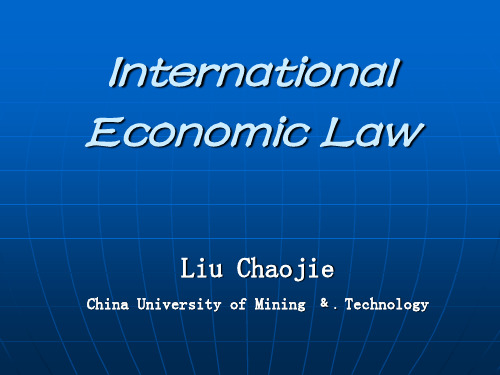
Chapter I General Introduction
Section Ⅲ Basic Principles of IEL 1974年5月联合国大会第6届特别会议通
过的《建立国际经济新秩序宣言》和《建 立国际经济新秩序行动纲领》,1974年 12月12日联合国大会第29届会议通过 《各国经济权利与义务宪章》是三个纲领 性文献。
Chapter I General Introduction
关于狭义的定义 关于教材的定义:调整国际经济活动和国际
经济关系。
Chapter I General Introduction
何谓国际经济关系? 狭义之说:仅指国家、国际组织间的经济关系。 广义之说:国际经济法所调整的国际经济关系既
渊源 此处指形式渊源 国际经济法的渊源包括: 国际经济条约、国际惯例、国际组织决议、 国内立法、示范法和其他辅助性渊源。
Chapter I General Introduction
一、国际经济条约
International Economic Treaties and Conventions Conventional International Economic Law
Chap则 ①各国对境内一切自然资源享有永久主权 ②各国对境内的外国投资以及跨国公司的
活动享有管理监督权 ③各国对境内的外国资产有权实施国有化
Chapter I General Introduction
2、公平互利原则 公平equity ['ekwiti]与平等equality
含义的区别:形式平等,实质平等 互利: 3、全球合作发展原则 4、有约必守原则
Chapter I General Introduction
国际金融学-国际收支不平衡的调节

(3)相比较追求国际收支量上的平衡而言,各国政府更重视追求国际收支 结构上的平衡。
(4)对于某些国家来说,在特殊时期,上述第四种情况的国际收支状况可 能是一种政策性的选择,即为了达到一定的政策目标,政府采取的一种策略。
CHAPTER ➢第二节 国际收支不平衡的原因及调节
一、国际收支不平衡的原因
(一)一般原因 1.周期性不平衡 周期性不平衡(cyclical disequilibrium)是指一国经济周期波动引起该国国 民收入、价格水平、生产和就业发生变化而导致的国际收支不平衡。 2.货币性不平衡 货币性不平衡(monetary disequilibrium)是指一国货币增长速度、商品成 本和物价水平与其他国家相比,如发生较大变化而引起的国际收支不平衡。
CHAPTER ➢第一节 国际收支不平衡的概念及其影响和评价
二、国际收支不平衡对经济的影响
(1)不利于对外经济交往。 (2)如果一国长期处于逆差状态,不仅会严重消耗一国的储备资产,影响 其金融实力,而且还会使该国的偿债能力降低,如果陷入债务困境不能自拔, 这又会进一步影响本国的经济和金融实力,并失去在国际上的信誉。
CHAPTER ➢第二节 国际收支不平衡的原因及调节
一、国际收支不平衡的原因
3.结构性不平衡 结构性不平衡(structural disequilibrium)是指当国际分工的结构(或世界 市场)发生变化时,一国经济结构的变动不能适应这种变化而产生的国际收支不 平衡。 4.收入性不平衡 收入性不平衡(income disequilibrium)是指由于各种经济条件的恶化引起 国民收入的较大变动而引起的国际收支不平衡。 5.临时性不平衡 临时性不平衡是指短期的由非确定或偶然因素引起的国际收支不平衡。
实用国际金融英语参考答案

《实用国际金融英语》参考答案Chapter 1Lead-in Activities1. Balance of payment data serve as record of the flows of goods, services and finance between an economy and the rest of the world. As one of the primary functions of the IMF is to prevent financial crises and assist countries in balance of payment difficulties, the collection of standardized, comparable balance of payment data is seen as a core task.BOP is a statistical statement that summarizes, for a specific period (typically a year or quarter), the economic transactions of an economy with the rest of the world. It covers:·All the goods, services, factor income and current transfers an economy receives from or provides to the rest of the world;·Capital transfers and changes in an economy’s external financial claims and liabilities.2. When a country has a surplus in its current account, i.e. when its exports exceed its imports, there will probably be a surplus in the balance of payment because the current account forms a very large proportion in the balance of payment. The surplus means the supply of foreign exchange exceeds demand. The monetary authority has to increase the purchase of the foreign currency and the stock of its international reserve. Meanwhile, the supply of domestic currency adds at an accelerated speed, which may lead to further issue of the local currency and cause inflation.3. When there is a long-lasting surplus in the balance of payment, particularly in the current account, there will also be excessive demand for its currency. The country’s exchange rate will rise, unless the central bank is willing to provide its currency to the market in exchange for foreign currencies. For example, when the export of the United States exceeds much more than import, a large quantity of US dollars are wanted by those importers to pay for the US goods. Thus, the exchange rate of US dollars rises.When the balance of payment has a long-lasting deficit, the payable debts denominated in foreign currencies are more than receivable claims; there will be a considerable demand for foreign currencies over the supply. As a result, the foreign currencies wanted appreciate, and the domestic one devalues.4.Temporary drop of surplus or moderate short-term deficit does not seriously affect a country’s economy or foreign trade. On one hand, deficit means larger amount of import than export in current account; on the other hand, it more likely shows an increasing demand of foreign currencies to pay for the imported goods. In other words, deficit may cause the raise of exchange rate of foreign hard currencies, which is conducive to the investors from the issuing countries of these appreciating currencies. This is surely good news to those that are in need of foreign investment. Temporary drop of surplus helps cool off the national economy and serves as a brake stopping ongoing inflation.5.The stock of international reserve should be neither more or less than necessary. The International Exchange Reserves are kept in the debit entry in BOP statements in that the monetary authority has to pay in exchange for the foreign hard currencies. Therefore, the amount and composition of exchange reserves are to be decided by taking the following factors into consideration.(1) The duration of the government’s external debt should be related to the duration of thereserves, with emphasis on the interest rate exposure risk.(2) High-risk-return assets should be limited within a safe range.(3) One of the most important issues raised in the context of investing the reserves of a centralbank is the choice of a reference basket.It is well recognized that the lowest level of the stock of international reserve should be no less than the amount payable for a 3-month import. And, the stronger an economy is, the less international reserve is to be kept.6. C7. CExercisesI. True or False1. F2. F3. F4. F5. F6. F7. F8. F9. F 10. F11. F 12. T 13. F 14. F 15. TII.Translation Task1.在与国际货币基金组织的技术援助使团于2000年上半年进行了磋商之后,国家外汇管理局吸取了国际通行的经验,以提高其国际收支报告的及时性。
克鲁格曼《国际经济学》(国际金融部分)课后习题答案(英文版)第一章

CHAPTER 1INTRODUCTIONChapter OrganizationWhat is International Economics About?The Gains from TradeThe Pattern of TradeProtectionismThe Balance of PaymentsExchange-Rate DeterminationInternational Policy CoordinationThe International Capital MarketInternational Economics: Trade and MoneyCHAPTER OVERVIEWThe intent of this chapter is to provide both an overview of the subject matter of international economics and to provide a guide to the organization of the text. It is relatively easy for an instructor to motivate the study of international trade and finance. The front pages of newspapers, the covers of magazines, and the lead reports of television news broadcasts herald the interdependence of the U.S. economy with the rest of the world. This interdependence may also be recognized by students through their purchases of imports of all sorts of goods, their personal observations of the effects of dislocations due to international competition, and their experience through travel abroad.The study of the theory of international economics generates an understanding of many key events that shape our domestic and international environment. In recent history, these events include the causes and consequences of the large current account deficits of the United States; the dramatic appreciation of the dollar during the first half of the 1980s followed by its rapid depreciation in the second half of the 1980s; the Latin American debt crisis of the 1980s and the Mexico crisis in late 1994; and the increased pressures for industry protection against foreign competition broadly voiced in the late 1980s and more vocally espoused in the first half of the 1990s. Most recently, the financial crisis that began in East Asia in 1997 andspread to many countries around the globe and the Economic and Monetary Union in Europe have highlighted the way in which various national economies are linked and how important it is for us to understand these connections. At the same time, protests at global economic meetings have highlighted opposition to globalization. The text material will enable students to understand the economic context in which such events occur.Chapter 1 of the text presents data demonstrating the growth in trade and increasing importance of international economics. This chapter also highlights and briefly discusses seven themes which arise throughout the book. These themes include: 1) the gains from trade;2) the pattern of trade; 3) protectionism; 4), the balance of payments; 5) exchange rate determination; 6) international policy coordination; and 7) the international capital market. Students will recognize that many of the central policy debates occurring today come under the rubric of one of these themes. Indeed, it is often a fruitful heuristic to use current events to illustrate the force of the key themes and arguments which are presented throughout the text.。
chapter1 国际汇兑与结算概述1

24
案例讨论
跨境贸易人民币结算
/NEWS/FINANCE/2014006/01B8822BC605-431D-A439-32089F46AAFC.SHTML
做中学、学中做!
2018/11/1
1981 523亿元
1991 9200亿元
2001 7.4万亿元
2007 17.3万亿元
800元
5900元
1.3万元 255万元
3
在货币超发洪流中,中国也 已经成长为世界巨人。
2018/11/1
4
宏观经济学告诉我们:
M0=流通中的现金,即我们通常所称的现金。 M1(狭义货币量)=M0+活期存款 M2(广义货币量)=M1+定期存款+储蓄存款+其他存款+证券公司客户保证金。
货物单据化、履约证书化,便于银行办理国际结算
(凭货付款到凭单付款)(From dealing in goods to
dealing in documents)
从买卖直接结算发展到通过银行结算(From payment
between buyers and sellers to payments effected through foreign exchange banks)
通常用广义货币供应量/国内生产总值(M2/GDP)的比例来说明货
币与实体经济之间的量化比例关系,反映一个经济体金融深化的程度。 一般而言,M2/GDP越大,货币超发越严重。
年份 GDP 1978 3645亿元 2009 33.54万亿元 比较结果 92倍
M2
0.0859Leabharlann 万亿60.62万亿元增加了705倍
由有形贸易引起的,是国际贸易的基础
(新英文)“国际金融”课后计算题答案

Chapter 1:9. Net debtor nation of the amount $25 billion.10. a. Merchandise trade balance, $75 billion deficit. Services balance, $60 billion surplus. Goods and services balance, $15 billion deficit. Investment income balance, $5 billion surplus. Unilateral transfers balance, $20 billion deficit. Current account balance, $30 billion deficit.b. Current account. The current account deficit implies that the United States is anet-demander of funds from the rest of the world.11. a-debit; b-credit; c-credit; d-debit; e-debit; f-debit; g-credit; h-debit; i-debit.Chapter 2:1. An arbitrager could purchase 3 francs with $1, purchase 6 schilling with 3 francs, and sell 6schilling for $1.50. Ignoring transaction costs, the arbitrager realizes a $0.50 profit on the transactions.2. a. The U.S. speculator should sell francs today for delivery in 3 months at today'sforward rate of the franc, which equals $0.50.b. After 3 months, if the franc's spot rate is $0.40, the speculator can purchase francsat the price of $0.40 each and deliver them for the previously contracted rate of$0.50 per franc; the speculator realizes a profit of $0.10 on each franc which theforward contract specifies. If the franc's spot rate after 3 months is $0.60, thespeculator must purchase francs at a price of $0.60 per franc and resell them at aprice of $0.50 per franc; the speculator would suffer losses of $0.10 on each francspecified in the forward contract. If the franc's spot rate after 3 months is $0.50,the speculator realizes neither a profit nor a loss on the transaction.3. a. The U.S. importer can cover her foreign exchange risk by purchasing 20,000 poundsfor three-month delivery at today's three-month forward rate of $1.75 per pound.The importer is willing to pay 5 cents more per pound than today's spot rate toguard against the possibility that the spot rate in three months will exceed $1.70 perpound. In three months, when her payments are due, the importer will pay$35,000 and get the 20,000 pounds needed for payment, irrespective of what thepound's spot rate is at that time.b. If the spot rate of the pound in three months is $1.80 per pound, and the U.S.importer does not obtain forward cover, she must pay $36,000 for the 20,000pounds; this amount exceeds by $1000 the cost of the pounds she incurs byhedging.4. a. 1.7090, 1.7105, 1.7084, 1.7099, 1.7081, 1.7096, 1.7090, 1.7103.b. $0.5851 per franc, $1.7090 francs per dollar.c. Depreciated, appreciated.d. $58.51, 170.9 francs.e. The 30-day forward franc was at a premium of $.0002 which equals 0.4 percent onan annual basis. The 90-day forward franc was at a premium of $.0003 whichequals 0.2 percent on an annual basis.5. Arbitragers will buy pounds in New York, at $1.69 per pound, and sell pounds in London, at$1.71 per pound, thus making a profit of 2 cents on each pound. As pounds are bought in New York, their prices rises; as pounds are sold in London, their price falls. When the dollar price of the pound equalizes in the financial centers, the profitability of arbitrage ceases and the practice stops.6. a. The U.S. investor would purchase pounds on the spot market at $2 per pound, anduse the pounds to buy U.K. treasury bills in London; he would earn 4 percentannually more than he would if he had purchased U.S. treasury bills in New York.b. Yes, by 0.5 percent.7. a. $1.50 per pound. 30 pounds are purchased at a cost of $45.b. Excess supply, 20 pounds. Dollar price of the pound decreases, decrease, increase.c. E xcess demand, 20 pounds. Dollar price of the pound increases, increase, decrease.Chapter 3:1. a. - 2 percent in the U.S., 2 percent in the U.K.b. Investment would flow from the U.S. to the U.K.c. T he dollar would depreciate against the pound.2. The dollar's exchange rate will:a. Depreciateb. Appreciatec. Appreciated. Appreciatee. Depreciatef. Depreciateg. Appreciate3. a. Dollar depreciates by 10 percent, to approximately $0.55 per franc.b. Dollar appreciates by 10 percent, to approximately $0.45 per franc.c. Dollar appreciates by 15 percent, to approximately $0.43 per franc.d. Dollar depreciates by 5 percent, to approximately $0.53 per franc.4. In the short run, changes in exchange rates are caused by relative interest rates and expectedchanges in exchange rates.5.More expensive, less expensive, increased, decreased7. a. Falseb. Truec. TrueChapter 5:1. a. Export quantity 1000Export price $3000Export receipts $3 millionImport quantity 150Import price $20,000Import payments $3 millionTrade balance $0b. The dollar depreciation improves (worsens) the U.S. trade balance when the sum ofthe export-demand elasticity and the import-demand elasticity are greater (less)than 1.0.c. Because the sum of the export-demand elasticity and the import-demand elasticityare less than 1.0, the U.S. trade balance will worsen.3. The 50 percent dollar appreciation results in a less-than 50 percent increase in the firm'sproduction cost in terms of the peso.7. The 50 percent dollar appreciation results in a 50 percent increase in the firm's production costin terms of the peso.。
国际金融(英文版第二版)Chapter 1 Balance of Payment

The difference between direct investment and portfolio investment revolves around whether or not the investor intends to take an active role in the management of the enterprise the assets of which are being acquired
Chapter 1 Balance of payments
1.1 International transactions: the balance of payments
The
balance of payments is the record of the economics and financial flows that take place over a specified time period between residents and non-residents of a given country.
The current account
The
trade balance
services
The trade balance comprises merchandise exports and impocial services include such things as freight, insurance, passenger services and travel.
Table 1.1 Standard components of the balance of payments
Current
account Exports fob - Imports fob = Trade balance + Exports of non-financial services - Imports of non-financial services + Investment income (credit) - Investment income (debit) +(-) Private unrequited transfers +(-) Official unrequited transfers = Current account balance Capital account +(-) Direct investment +(-) Portfolio investment +(-) Other long-term capital +(-) Other short-term capital +(-) Net errors and omissions +(-) Counterpart items +(-) Total change in reserves = Capital account balance
chapter 1国际收支与外汇储备
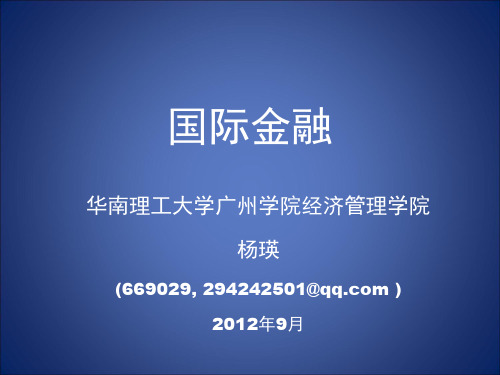
外币支付凭证或者支付工具,包括票据、银行存款凭证等
外币有价证券,包括债券、股票等
特别提款权 摘自:《中华人民共和国外汇管理条例》
外 汇 与 外 币
- 特点:具有真实的债权债务基础;可兑换货币;能 用以偿还国际债务
• IMF采用的广义定义:在一定时期内一国 居民与非居民之间全部经济交易的系统记 录。 – 居民与非居民间的交易 center of economic interest – 国际收支反应的内容以交易为基础 on Transaction Basis /on cash payment basis – 国际收支是一个流量的概念
定金额的贷方记录
• 贸易差额:
– 贸易盈余surplus
国 际 收 支 平 衡 表
– 贸易赤字deficit
包含的内容
1. 经常账户current account – – – 货物:一国的对外贸易收支 服务:无形贸易收支 收益:劳动力与资本在国际间流动而发生的外汇收支。
(职工报酬、投资所得等)
– 经常转移:政府与私人的无偿转移
2. 资本和金融账户capital account –
资本账户:资本转移——投资捐赠和债务注销的外汇收支; 非生产、非金融资产的收买与出售(土地、矿藏,专利权、 商标权等)
国 际 收 支 平 衡 表
–
金融账户:直接投资、间接投资、其他投资等
包含的内容
3. 净差错与遗漏net errors and omissions
借:商品进口 1000万美元
贷:外国对我国的直接投资1000万美元
国际收支记账实例
4. 我国政府动用外汇库存40万美元向外国提供无 偿援助,另提供相当于于60万美元的粮食药品 援助 借:经常转移 100万美元 贷:官方储备 40万美元 商品出口 60万美元
Chapter_1__The_Balance_of_Payment

Ⅱ
Slide 1-5
National accounts
国民经济 账户
Result
reflected in a prominent role
Slide 1-6
Balance of payments
国际收支 平衡表
Exchange rate
1.1 Double-Entry Accounting
U.S. credit transaction (+)
Merchandise exports 商品出口 Transportation and travel receipts 运输及旅游收入 Income received from investments abroad 海外投 资所获得的收入 Gifts received from foreign residents外国居民捐赠 Aid received from foreign governments 外国政府 援助 Investments in the United States by overseas residents外国居民在美国的投资
Payment to foreigners
Debit transaction (-) 借方交易
国际收支平衡表中所用记账方法是国际上通行的 借贷复式记账法 ,每一笔国际经济交易都要以同 一数额出现两次,一次在借方,一次在贷方
Slide 1-21
Business School
fsxycyf@
IMF(International Monetary Fund) WTO(World Trade Organization ) BIS(Bank for International Settlements) OECD(Organization for Economic Co-operation and Development ) EU(European Union)
国际金融知识重点
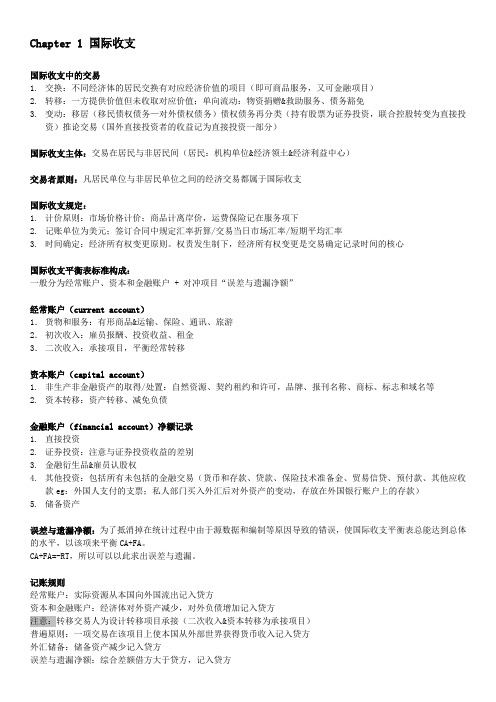
Chapter 1 国际收支国际收支中的交易1.交换:不同经济体的居民交换有对应经济价值的项目(即可商品服务,又可金融项目)2.转移:一方提供价值但未收取对应价值;单向流动:物资捐赠&救助服务、债务豁免3.变动:移居(移民债权债务—对外债权债务)债权债务再分类(持有股票为证券投资,联合控股转变为直接投资)推论交易(国外直接投资者的收益记为直接投资一部分)国际收支主体:交易在居民与非居民间(居民:机构单位&经济领土&经济利益中心)交易者原则:凡居民单位与非居民单位之间的经济交易都属于国际收支国际收支规定:1.计价原则:市场价格计价;商品计离岸价,运费保险记在服务项下2.记账单位为美元;签订合同中规定汇率折算/交易当日市场汇率/短期平均汇率3.时间确定:经济所有权变更原则。
权责发生制下,经济所有权变更是交易确定记录时间的核心国际收支平衡表标准构成:一般分为经常账户、资本和金融账户 + 对冲项目“误差与遗漏净额”经常账户(current account)1.货物和服务:有形商品&运输、保险、通讯、旅游2.初次收入:雇员报酬、投资收益、租金3.二次收入:承接项目,平衡经常转移资本账户(capital account)1.非生产非金融资产的取得/处置:自然资源、契约租约和许可,品牌、报刊名称、商标、标志和域名等2.资本转移:资产转移、减免负债金融账户(financial account)净额记录1.直接投资2.证券投资:注意与证券投资收益的差别3.金融衍生品&雇员认股权4.其他投资:包括所有未包括的金融交易(货币和存款、贷款、保险技术准备金、贸易信贷、预付款、其他应收款eg:外国人支付的支票;私人部门买入外汇后对外资产的变动,存放在外国银行账户上的存款)5.储备资产误差与遗漏净额:为了抵消掉在统计过程中由于源数据和编制等原因导致的错误,使国际收支平衡表总能达到总体的水平,以该项来平衡CA+FA。
国际金融课件--Chapter 1. Balance of Payment
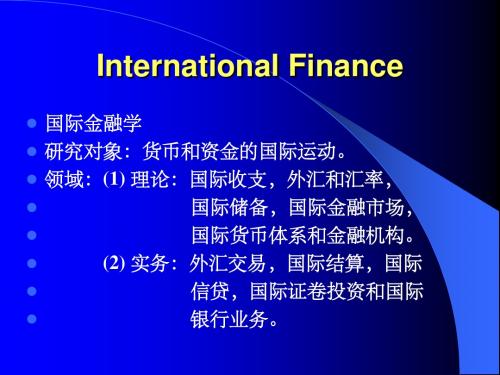
Other service
(2) Imports Of which: Merchandise
Investment income paid
-716.6 -489.4 -108.9 -118.3
+8.0 -3.7
Other services (3) Net unilateral transfers
Balance on current account
黄金输出
本币下跌
银行准备金 下跌 出口增加
逆 差
顺 差
本币上升
进口增加
银行准备金 增加
黄金输入
物价与现金流动机制 流程图 国际收支逆差 黄金外流
通货紧缩 物价下跌 出口增加,进口减少
国际收支平衡
IFM’s Definition
1. 2. 3.
4.
一个经济实体与其他经济实体的商品, 劳务和收益的转移。 这个经济实体债权债务的变化以及特别 提款权,货币黄金的变动。 无需偿还的单方面转移。 会计上需要用来平衡未被抵消的对外交 易的对应科目。
Main Items
二 国际收支平衡表的主要内容 (一)经常项目Current Account (二)资本项目Capital Account (三)平衡项目Balancing Account
Error and Omission-2
。从总量看,我国的国际收支在“错误与遗 漏项目”累积了相当大的规模。据统计在 1982年-1998间,我国国际收支平衡表中 “错误与遗漏项目”累计高达1082·亿美元。 4 从年度规模看,1994年到1998年我国国际收 支平衡表中的“误差与遗漏项目”则分别高 达98亿美元、178亿美元、156亿美元、169亿 美元、166亿美元。巨大的资本外逃不仅影响 到我们对国际收支形势的正确把握,影响对 宏观经济走势的准确分析,而且也反映出资 本外逃问题的加剧。
Chapter1_Connolly 国际金融
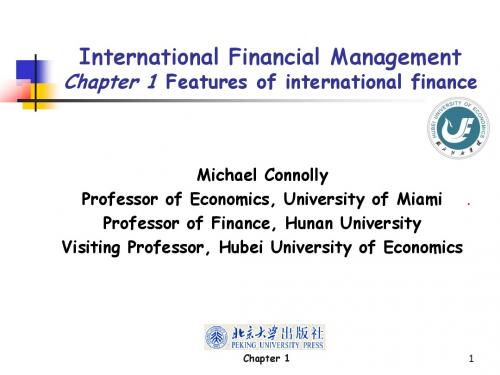
An unanticipated loss
Chapter 1
Page 10
Currencies
Exchange rate risk Translation exposure Accounting requirement: US Federal Accounting Standards Board (FASB) 52 requires conversion of most line items at the current exchange rate to the USD for reporting of income and financs
Exchange rates American quotations vs. European quotations
American: USD per unit of foreign currency
Example: 1.561519 USD for 1 GBP 0.151065 USD per CNY (Chinese yuan)
The banks buy 1 billion USD at 6.36968851 and sell them at 6.38558027. The bid-ask spread: 6.385580276.6968851 = 0.01589176. RMB profits on the 1 billion dollars traded equal 15,891,760.
Chapter 1 Page 13
Operational exchange risk: Nissan
The dollar fell to 80.41 yen against the yen Monday, its lowest since April 1995 and near its record low of 79.75 yen, before rebounding Tuesday. Each one-yen fall in the dollar slashes Nissan's operating profit by 15 billion yen, the company has said. Mr. Shiga declined to comment on whether the company would change its assumption for the dollar for this fiscal year from the current 90 yen, saying only that Nissan will explain further when it reports its July-September earnings on Thursday next week. Nissan said in July that it earned nearly half its expected operating profit for the full fiscal year in the first quarter, but it didn't lift its full-year forecast at the time partly because of the difficult outlook for the yen. The auto maker is reducing exports from Japan while increasing imports as a short-term measure to cope with the strong yen, Mr. Shiga said. The company needs to speed up shifting production overseas in the long term, he added. The car maker plans to produce 1.1 million vehicles in Japan during the current fiscal year through March.
国际金融练习题答案Chapter 1 Globalization and the Multinational Enterprise exercise answer

Chapter 1Globalization and the Multinational Enterprise1.1Multiple Choice and True/False Questions1) Which of the following are critical to a firm trying to reach the top of the "firm value pyramid"?A)an open market placeB) high quality strategic managementC) access to capitalD) all of the above2) A well-established, large firm U.S.-based MNE will probably not be able to overcome which of the following obstacles to maximizing firm value?A) an open market placeB) high quality strategic managementC)access to capitalD)none of the above3)Three necessary conditions for a firm to reach the top of the "firm value pyramid" are an open market place, high quality strategic management, and access to capital.4)A well-established, large China-based MNE will probably be most adversely affected by which of the following elements of firm value?A) an open marketplaceB) high-quality strategic managementC)access to capitalD)access to qualified labor pool5)A well-established, large, Brazil-based MNE will probably be most adversely affected by which of the following elements of firm value?A) an open marketplaceB)high-quality strategic managementC)access to capitalD)access to qualified labor pool6)The theory that suggests specialization by country can increase worldwide production is ________.A)the theory of comparative advantageB) the theory of foreign direct investmentC) the international Fisher effectD)the theory of working capital management7)Which of the following would NOT be a way to implement comparative advantage?A)IBM exports computers to Egypt.B)Computer hardware is designed in the United States but manufactured and assembled in Korea.C)Water of the greatest purity is obtained from wells in Oregon, bottled, and exported worldwide.D) All of the above are examples of ways to implement comparative advantage.8) Which of the following would NOT be considered a feature of comparative advantage?A)Exporters in Country A sell goods or services to unrelated importers in Country B.B) Firms in Country A specialize in making products that can be produced relatively efficiently, given County A's endowment of factors of production. Firms in Country B do likewise thus maximizing the combined output of Countries A and B.C)Trade exists between Counties A and B because of specialized factors of production that cannot be moved among countries.D) All of the above are features of comparative advantage.9)Of the following, which would NOT be considered a way that government interferes with comparative advantage?A)tariffsB)managerial skillsC)quotasD)other non-tariff restrictions10)Comparative advantage shifts over time as less developed countries become more developed and realize their latent opportunities.11) Comparative advantage was once the cornerstone of international trade theory, but today it is archaic, simplistic, and irrelevant for explaining investment choices made by MNEs.12)In determining why a firm becomes multinational there are many reasons. One reason is that the firm is a market seeker. Which of the following is NOT a reason why market seeking firms produce in foreign countries?A)satisfaction of local demand in the foreign countryB)satisfaction of local demand in the domestic marketsC)political safely and small likelihood of government expropriation of assetsD)All of the above are market-seeking activities.13) ________ investments are designed to promote and enhance the growth and profitability of the firm. ________ investments are designed to deny those same opportunities to the firm's competitors.A)Conservative; aggressiveB)Defensive; proactiveC)Proactive; defensiveD)Aggressive; proactive14) Which of the following is NOT considered to be a type of competitive advantage that may be enjoyed by an MNE?A) managerial and marketing expertiseB) superior technology due to investment in research and developmentC)increased agency costsD) differentiated products15)Which of the following is NOT considered to be a type of competitive advantage that may be enjoyed by an MNE?A) competitiveness in their home marketsB) foreign exchange risksC) economies of scaleD) economies of scope16) The phase of the globalization process characterized by imports from foreign suppliers and exports to foreign buyers is called theA)domestic phase.B) multinational phase.C) international trade phase.D) import-export banking phase.17) The authors describe the multinational phase of globalization for a firm as one characterized by theA)ownership of assets and enterprises in foreign countries.B) potential for international competitors or suppliers even though all accounts are with domestic firms and are denominated in dollars.C) imports from foreign suppliers and exports to foreign buyers.D) requirement that all employees be multilingual.18) Of the following, which was NOT mentioned by the authors as an increase in the demands of financial management services due to increased globalization by the firm?A) evaluation of the credit quality of foreign buyers and sellersB)foreign consumer method of payment preferencesC) credit risk managementD)evaluation of foreign exchange risk19)The authors describe the multinational phase of globalization for a firm as one characterized by theA) ownership of assets and enterprises in foreign countries.B) potential for international competitors or suppliers even though all accounts are with domestic firms and are denominated in dollars.C) imports from foreign suppliers and exports to foreign buyers.D) requirement that all employees be multilingual.20) Of the following, which was NOT mentioned by the authors as an increase in the demands of financial management services due to increased globalization by the firm?A)evaluation of the credit quality of foreign buyers and sellersB) foreign consumer method of payment preferencesC) credit risk managementD)evaluation of foreign exchange risk21) Typically, a firm in its domestic stage of globalization has all financial transactions in its domestic currency.22)A firm in the International Trade Phase of GlobalizationA)makes all foreign payments in foreign currency units and all foreign receipts in domestic currency units.B)receives all foreign receipts in foreign currency units and makes all foreign payments in domestic currency units.C) bears direct foreign exchange risk.D) none of the above.23) The exposure to foreign exchange risk known as Translation Exposure may be defined asA) changes in reported owners' equity in consolidated financial statements caused by a change in exchange rates.B) the impact of settling outstanding obligations entered into before change in exchange rates but to be settled after change in exchange rates.C)the change in expected future cash flows arising from an unexpected change in exchange rates.D)all of the above.24)The twin agency problems limiting financial globalization are caused by these two groups acting in their own self-interests rather than the interests of the firm.A)rulers of sovereign states and unsavory customs officialsB) corporate insiders and attorneysC) corporate insiders and rulers of sovereign statesD) attorneys and unsavory customs officialsChapter 1 Globalization and the Multinational Enterprise exercise answer1、A 2 、D 3、T 4、A 5、C 6、A 7、D 8、D 9、B 10、T 11、F 12、C13、C 14、C 15、B 16、C 17、A 18、B 19、A 20、B 21、T 22、C 23、A 24、C25、C 26、B 27、C 28、A 29、A 30、CTABLE 1.1Use the information in the table to answer following question(s).25) Refer to Table 1.1. A production unit in Austria has a/an ________ over a production unit in Russia in ________.A) absolute disadvantage; digital camerasB) absolute disadvantage; snowboardsC) absolute advantage; both cameras and snowboardsD) none of the above26) Refer to Table 1.1. Austria has a larger relative advantage over Russia in the production of ________ at a ratio of ________.A) snowboards; 5 to 4B) cameras; 8 to 3C) snowboards; 8 to 3D) cameras; 3 to 827) Refer to Table 1.1. Assume no trade between Russia and Austria. If each country put 50% of their production units into each product, the total number of snowboards and digital cameras produced by the two countries combined are ________ and ________.A) 15,000 snowboards; 3,000 digital camerasB) 6,000 snowboards; 4,000 digital camerasC) 2,750 digital cameras; 6,750 snowboardsD) 15,000 digital cameras; 1,000 snowboards28) Refer to Table 1.1. If trade takes place at Brazil's domestic price, ________ snowboards will be required to obtain 1 digital camera.A) 4B) 2 and 2/3C) 1.25D) 0.2529) Refer to Table 1.1. If each country specializes in their production with Austria producing only digital cameras and Russia producing only snowboards, at a trading rate of three snowboards per digital camera, how many cameras and snowboards will be available to be consumed in Austria if they trade 3,000 cameras to Russia?A) 9,000 snowboards and 5,000 digital camerasB) 3,000 snowboards and 3,000 digital camerasC) 3,000 snowboards and 9,000 digital camerasD) There is not enough information to answer this question.30) Refer to Table 1.1. If each country specializes in their production with Austria producing only digital cameras and Russia producing only snowboards, at a trading rate of three snowboards per digital camera, how many cameras and snowboards will be available to be consumed in Russia if they trade 9,000 snowboards to Austria?A) 9,000 snowboards and 5,000 digital camerasB) 3,000 snowboards and 3,000 digital camerasC) 3,000 snowboards and 9,000 digital camerasD) There is not enough information to answer this question.。
- 1、下载文档前请自行甄别文档内容的完整性,平台不提供额外的编辑、内容补充、找答案等附加服务。
- 2、"仅部分预览"的文档,不可在线预览部分如存在完整性等问题,可反馈申请退款(可完整预览的文档不适用该条件!)。
- 3、如文档侵犯您的权益,请联系客服反馈,我们会尽快为您处理(人工客服工作时间:9:00-18:30)。
The Environment of International Finance
Economic integration refers to the extent and strength of real sector and financial sector linkages among national economies. International markets are integrated when assets sell for the same price in every country. Globalization includes market integration, world governance, global society and mobility of people and information. Rapid growth of world trade and finance
International finance studies cross-border capital movements resulted from political, economical and cultural linkages or contacts among different countries. It is a constantly evolving subject that deals very much with real world issues such as balance of payments and policies, the cause of exchange rate movements and the implications of macroeconomic linkages between countries.
An increase in cross-border financing
Increasingly interdependent national financial markets An increasing number of cross-border partnerships An increasing number of cooperative linkages among securities exchanges
Spot Outright forwards FX swaps Currency swaps
Options and others Turnover
568 128 734 10
87 1,705
386 130 656 7
60 1,505
631 209 954 21
119 2,040
1,005 362 1,714 31
Global foreign exchange market turnover by instrument (average daily turnover in April, billions of U.S. dollars)
Instrument FX instruments 1998 1,527 2001 1,239 2004 1,934 2007 3,324 2010 3,981
World North America United States Europe Germany France United Kingdom CIS Africa Asia Japan China
15,050 2,681 1,968 5,841 1,087 606 558 414 463 4,503 693 1,395 174
David Ricardo developed a principle to show that mutually beneficial trade can occur even when one nation is absolutely more efficient in the production of all goods. Example Production Capability Units of wheat Units of cars 24 12 20 4
Trade at a price of 4 units of wheat to 1 unit of car
U.K. France
Wheat Production 12,800 (import) 20,000 – 12,800 = 7,200
00
01
02
03
04
05
06
07
08
09
Borrower’s reliance on foreign banks In percent
00
01
02
03
04
05
equences of the integration of the world’s financial markets
Specialization in U.K. and France
Wheat Production (units) Car Production (units) U.K. 0 1,000 x 12 = 12,000 France 1,000 x 20 = 20,000 0 Total output 20,000 12,000
U.K. France
Production of U.K. and France before trade
Wheat Production (units) Car Production (units) U.K. 300 x 24 = 7,200 700 x 12 = 8,400 France 300 x 20 = 6,000 700 x 4 = 2,800 Total output 13,200 11,200
The BOP is one of the most important economic indicators for the policy-makers in an open economy. It influences a country’s employment rate, interest rate, exchange rate and many other economic variables. Foreign exchange rate is the core subject matter in the theory of international finance. How the exchange rate is determined and why the exchange rate changes from time to time?
Growth in volume of world merchandise trade and GDP 2000 – 2011 (annual percentage change)
Figures for 2011 are projections Source: WTO Secretariat
Growth in world merchandise import by selected regions and economies (annual percentage change)
Financial derivatives such as currency futures, options and swaps provide valuable tools with the companies who face foreign exchange risk exposures. On the other hand, the derivatives are also used extensively for speculations. Some economists believe they are the major causes for 2008 world crises. Some firms, banks, and authorities have run up enormous losses either through taking of unduly risky positions or a lack of understanding the instruments.
212 3,370
1,490 475 1,765 43
207 3,981
Exchange-traded derivatives
11
12
26
80
168
Size of the financial sector (value added) In percent
84
89
94
99
04
09
Share of foreign lending in developed economies (In percent)
LCDs
Ratio of world exports of goods and commercial services to GDP, 1980 -2010
Source: IMF for world GDP, WTO secretariat for world goods and commercial services
2010 2005-2010 7 3 3 5 7 4 2 14 13 11 6 16 15 2008 16 8 7 13 12 13 2 32 28 21 23 18 30 2009 -23 -25 -26 -25 -22 -22 -24 -33 -15 -20 -28 -11 -5 2010 21 23 23 13 15 8 15 24 14 32 25 39 13
International Finance
School of International Finance Shanghai Finance University
